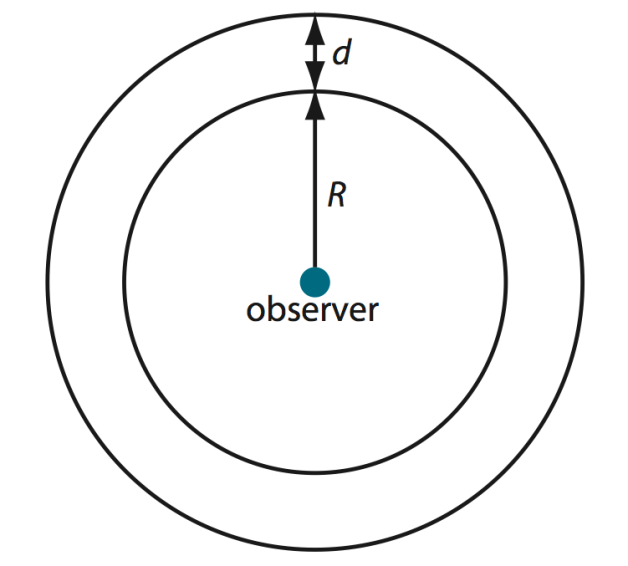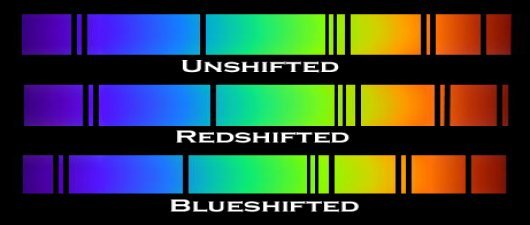Nowadays the universe is believed to have began with the big bang. The universe began from a singularity, a spot of infinite density where the four fundamental forces, gravity, the strong and weak nuclear forces, and the electromagnetic force were united. Before this explosion, time and space did not exist.
However, for many years, it was thought that the universe was static, stationary and infinite. In fact the great physicist and mathematician, Isaac Newton believed this as well, arguing that unless this was correct, the universe would become a spherical mass, as all the stars would have been attracted together, by gravitation. But it was a German amateur astronomer, Henrich Olber, who disproved Newton’s theory. The famous Olber’s paradox states that if the universe was infinite and stationary, then the whole sky would be bright. If one was to look at any direction the night sky would be bright because, there would be an infinite number of stars in any given direction. This can be mathematically shown by a simple proof.
Imagine the stars are distributed in a layer with a density of ρ, thus the number of a stars would seem to be the density, ρ, multiplied by the thickness of the layer, d, multiplied by the surface area of the layer, which is that of a sphere, 4πR2. Thus the number of stars that would be visible would be 4πR2ρd. The volume of visible stars would increase by R2, however, luminosity would decrease by 1/R2. Thus luminosity would be equal anywhere. The distance of R2 would cancel out, leaving the luminosity to be 4πρd, which would only depend on the thickness d, and the density ρ, not on the location of the observer.
The night sky however, is dark and thus we can conclude that the universe is not infinite or static, but changes with time. The big bang model states that the universe is constantly expanding, and that the distribution of stars is not uniform, resolving Olber’s paradox. However there are many other factors which support the big bang. The first is redshift. This is a phenomena which occurs with radiation emitted from stars that are moving away from us. This is similar to the Doppler Effect.
The Doppler Effect: The changing of frequency which arises from the relative motion between a source and observer
However, the rarefaction or stretching of light waves is actually not due to the Doppler Effect, instead it is due to the fabric of spacetime itself increasing. Since the big bang, the universe has been increasing in size. If a photon leaves a nearby galaxy, it spends a considerable time in space. But the space where it is moving is actually being increased in size, thus the longer a particle spends travelling in space, the more the light is rarefacted. As electromagnetic radiation travels at a constant speed, the amount of redshift can be use to determine how far away an object is, and also suggests to us that the universe is expanding. When the particle reaches us, it will have been redshifted, showing us how the universe is expanding, from a central point, suggesting the big bang model is correct.
This relationship can be expressed mathematically by the formula,
Δλ/λ=v/c
Where Δλ = λ’- λ, where λ is the wavelength from a stationary source, and λ’ is the wavelength measured from the source that is moving at speed v , and c is the speed of light
The third factor which supports the big bang is to do with the amount of helium in the universe. In fact 24% of the universe is helium, but the percentage is too high to be solely produced by fusion in stars, suggesting that the helium was made elsewhere. Two physicists, Dicke and Peebles, suggested that this helium was formed in the early universe, when temperatures were large enough to allow hydrogen fusion. In these reactions, high energy photons would have also been produced. But when later, two physicists Penzias and Wilson positioned an aerial facing space, they encountered constant cosmic background radiation that seemed to have been emitted from a black body of only 2.726K. (Click this link for information about Wien’s Law) However, the temperatures for hydrogen fusion would have been much larger than this. The wavelength of this radiation must have increased, supporting the idea of an expanding universe once more, and the big bang.
There are numerous other factors which support the big bang, such as the existence of quasars, and large gas clouds. To summarise we will list the three factors which support the big bang model, which you may have to list in an exam paper.
The three factors which support the Big Bang model
- Olber’s Paradox
- Redshift / The Expanding Universe
- Amount of Helium / Cosmic Background Radiation



 After government intervention, in this case negative advertising, a decrease in demand occurs and demand shifts left from D to D1, meaning that the externality has decreased in size. Continuing the smoking example, on most cigarette packets the government enforces mandatory negative advertising, such as pictures of cancers. After the decrease in demand, D1 intersects S at a lower quantity, so Q1 is now closer to Qopt, meaning that the quantity supplied is now more favourable from society’s point of view. Thus the pink externality has decreased in size, meaning that society is less worse off.
After government intervention, in this case negative advertising, a decrease in demand occurs and demand shifts left from D to D1, meaning that the externality has decreased in size. Continuing the smoking example, on most cigarette packets the government enforces mandatory negative advertising, such as pictures of cancers. After the decrease in demand, D1 intersects S at a lower quantity, so Q1 is now closer to Qopt, meaning that the quantity supplied is now more favourable from society’s point of view. Thus the pink externality has decreased in size, meaning that society is less worse off.